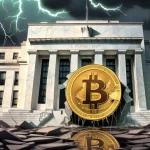Crypto.com’s 70B CRO Minting Approved, Sparks Community Fury and Price Drop

Crypto.com’s Last-Minute Vote Approves 70 Billion CRO Minting, Sparks Outrage
In a move that left the crypto community feeling betrayed, Crypto.com pulled a fast one with a last-minute vote to mint 70 billion CRO tokens, reversing a significant token burn from 2021. This decision has sparked a fierce debate about trust and decentralization within the Cronos ecosystem.
- Last-minute voting surge approves 70 billion CRO minting
- Reverses 2021 token burn
- Community backlash over trust and decentralization
The Vote
The proposal to mint 70 billion CRO tokens was narrowly approved with a 61.18% approval rate after a last-minute voting surge. In blockchain governance, a “quorum” refers to the minimum number of votes needed for a decision to pass, which in this case was set at 33.4%. Crypto.com’s own validators, including Starship, Falcon Heavy, Electron, Antares, and Minotaur IV, played a crucial role in swaying the vote in favor of the proposal. Critics argue that this heavy-handed approach undermines the decentralized ethos that blockchain technology is supposed to uphold.
Token burning is the process of permanently removing tokens from circulation, often to increase scarcity and potentially the value of the remaining tokens. Minting, on the other hand, is the creation of new tokens. Crypto.com’s decision to reverse the 2021 token burn has been seen by many as a betrayal of the initial value proposition that attracted investors.
Community Reaction
The crypto community’s reaction was swift and furious. One large CRO holder told Unchained, “Crypto.com’s last-minute votes set a precedent where projects with enough validator control could push decisions through despite opposition.” The frustration was palpable, with a CRO validator calling it a “spit in all CRO holders’ faces.”
The decision to mint 70 billion CRO tokens has raised serious concerns about the governance structure of the Cronos ecosystem. With Crypto.com controlling an estimated 70-80% of the voting power, the platform’s ability to push through such significant changes despite community opposition is a red flag for many.
Price Impact
The backlash was immediate, with CRO’s price dropping over 3% to $0.08 following the vote. Some in the community have even suggested that if the total supply increases to 100 billion CRO, the price could plummet to below $0.01. This potential long-term impact on CRO’s value is a major concern for investors.
Subsequent Actions by Crypto.com
In an attempt to quell the unrest, Crypto.com introduced a subsequent proposal to burn 50 million CRO tokens. However, this gesture was met with further criticism, as it represents just 0.07% of the newly minted supply. The community sees this as a token effort rather than a meaningful step towards addressing their concerns.
Analysis of Decentralization
The controversy surrounding Crypto.com’s decision highlights the tension between centralized control and the decentralized ethos that many in the crypto space hold dear. The reversal of the 2021 token burn, which was heralded as the “largest token burn in history,” has led to accusations of Crypto.com undermining the initial value proposition that drew many investors to the platform.
Decentralization is a core principle of blockchain technology, where control is distributed among many participants rather than concentrated in the hands of a few. Crypto.com’s significant control over the voting power raises serious questions about the true decentralization of the Cronos ecosystem. As Laura Shin’s sources on Unchained pointed out, this level of control undermines the trust that is essential for the platform’s long-term success.
Future Implications
The situation could have long-lasting effects on Crypto.com’s reputation and the trust of its user base. The community’s frustration is compounded by the silence from Crypto.com’s CEO, Kris Marszalek, who has recently focused on financial stability rather than addressing the controversy head-on.
Some community members have suggested solutions such as gradual token reintroduction with a burn mechanism, holder compensation, and governance reforms to prevent centralized control in the future. The controversy may also attract regulatory scrutiny, raising questions about the transparency and fairness of Crypto.com’s operations.
Key Takeaways and Questions
- What was the result of Crypto.com’s proposal to mint 70 billion CRO tokens?
The community approved the proposal with a 61.18% approval rate after a last-minute voting surge.
- Why did Crypto.com propose to mint these tokens?
Crypto.com claimed the minted tokens would support long-term growth, funding initiatives like AI applications and a CRO-based ETF.
- What concerns were raised by critics regarding the proposal?
Critics argued that reviving previously burned tokens undermines trust and raises concerns about Cronos’ decentralization, suggesting that Crypto.com’s control over validators allowed it to push the decision through despite opposition.
- How did the community react to the decision?
The community expressed frustration, with some describing the decision as a betrayal of the original burn commitment, leading to a decline in CRO’s price.
- What was the impact on CRO’s price following the vote?
CRO’s price dropped over 3% to $0.08 following the vote.
- What was the subsequent action taken by Crypto.com after the minting vote?
Crypto.com introduced a proposal to burn 50 million CRO tokens, which drew further criticism as it was just 0.07% of the newly minted supply.
As the dust settles on this contentious decision, the crypto community watches closely to see if Crypto.com can regain the trust it has lost. The incident serves as a stark reminder of the delicate balance between growth and governance in the world of decentralized finance. Crypto.com’s next moves will be crucial in determining whether it can navigate this crisis and emerge stronger or if it will continue to face the wrath of a disillusioned community.



